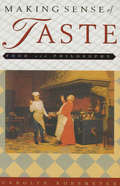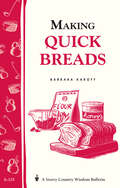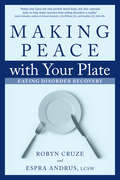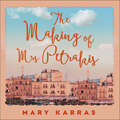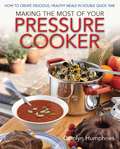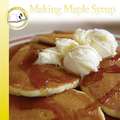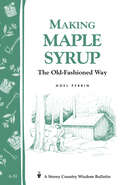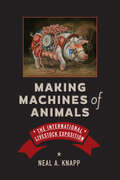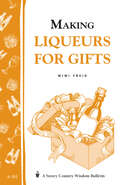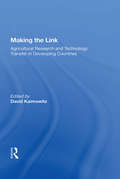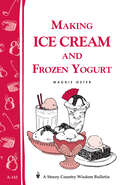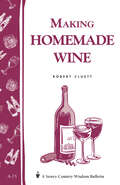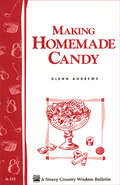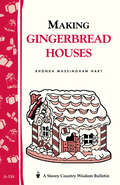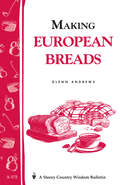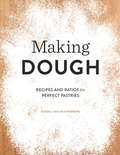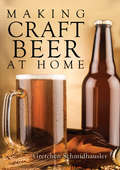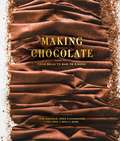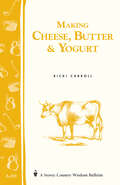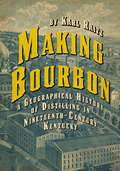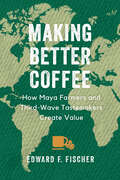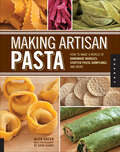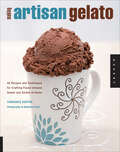- Table View
- List View
Making Sense of Taste: Food and Philosophy
by Carolyn KorsmeyerTaste, perhaps the most intimate of the five senses, has traditionally been considered beneath the concern of philosophy, too bound to the body, too personal and idiosyncratic. Yet, in addition to providing physical pleasure, eating and drinking bear symbolic and aesthetic value in human experience, and they continually inspire writers and artists.In Making Sense of Taste, Carolyn Korsmeyer explains how taste came to occupy so low a place in the hierarchy of senses and why it is deserving of greater philosophical respect and attention. Korsmeyer begins with the Greek thinkers who classified taste as an inferior, bodily sense; she then traces the parallels between notions of aesthetic and gustatory taste that were explored in the formation of modern aesthetic theories. She presents scientific views of how taste actually works and identifies multiple components of taste experiences.Turning to taste's objects—food and drink—she looks at the different meanings they convey in art and literature as well as in ordinary human life and proposes an approach to the aesthetic value of taste that recognizes the representational and expressive roles of food. Korsmeyer's consideration of art encompasses works that employ food in contexts sacred and profane, that seek to whet the appetite and to keep it at bay; her selection of literary vignettes ranges from narratives of macabre devouring to stories of communities forged by shared eating.
Making Quick Breads: Storey's Country Wisdom Bulletin A-135 (Storey Country Wisdom Bulletin Ser.)
by Barbara KaroffSince 1973, Storey's Country Wisdom Bulletins have offered practical, hands-on instructions designed to help readers master dozens of country living skills quickly and easily. There are now more than 170 titles in this series, and their remarkable popularity reflects the common desire of country and city dwellers alike to cultivate personal independence in everyday life.
Making Peace with Your Plate
by Robyn Cruze Espra AndrusAnorexia has the highest mortality rate of any mental illness. Binge-eating disorder (BED) and bulimia can also bring misery and death. Pushing the River, with its unique three-phase approach to eating, smashes the illusion of control, the power, and the lies of this deadly illness, providing a concrete plan for long-term recovery from the disease of disordered eating.
The Making of Mrs Petrakis: a novel of one family and two countries
by Mary KarrasA story of the choices women have to make to survive, and a portrait of ordinary lives marked by loss and war and grief, split between war-torn Cyprus and north London in the 1970s and 1980s.Cyprus in the run up to the civil war of the 1970s... the threat of it hangs in the atmosphere like a fine mist. A terrible thing, war. Against this backdrop of war and violence, the island's inhabitants make the best they can of their lives, building friendships, falling in love, having children, watching people die, making mistakes.Maria Petrakis, however, flees a brutal marriage on the island where she has always lived for London and a new start. She opens a bakery on Green Lanes in Harringay - the centre of the small Greek Cypriot community whose residents have settled there to escape the war and start again. Here she comes into her own as she heals and atones through the kneading of bread and the selling of shamali cakes and cinnamon pastries to her customers.There are glimpses of the lives of her neighbours, friends and customers as they buy their bread and cakes. There's Mrs Koutsouli, whose heart was broken when her handsome son married a xeni, an English woman with fish-eyes and yellow hair. There's Mrs Pantelis, driven half-mad with the grief of losing her son, Nico, in the war. And there's Mrs Vasili who claims to be related to Nana Mouskouri and grows her hair upwards so she can feel closer to God. Finally, there's Elena, Maria Petrakis' daughter-in-law, who has been suffering with the blackness since having a baby, and whom nobody knows quite how to help.The Making Of Mrs Petrakis is a story about the limited choices women sometimes find themselves confronting. It's a story about repression and mental illness and the devastation it can wreak on lives. But above all, it is a story of motherhood and love and of healing through the humble act of baking.(P) 2021 Hodder & Stoughton Ltd
Making The Most Of Your Pressure Cooker: How To Create Healthy Meals In Double Quick Time
by Carolyn HumphriesThis book will help you make the most of this invaluable and fuel-efficient kitchen appliance so that you can create really tasty meals in a fraction of the time with conventional methods. The result is that you'll save money, time and energy. But that's not all. Because pressure cooking is effectively steaming, it keeps in so much more of the natural goodness content of foods and is therefore much healthier too.In Making the Most of Your Pressure Cooker you'll discover how to pressure-cook complete meals, soups, desserts, vegetables and even preserves in double quick time.
Making Maple Syrup: Storey's Country Wisdom Bulletin A-51
by Noel PerrinSince 1973, Storey's Country Wisdom Bulletins have offered practical, hands-on instructions designed to help readers master dozens of country living skills quickly and easily. There are now more than 170 titles in this series, and their remarkable popularity reflects the common desire of country and city dwellers alike to cultivate personal independence in everyday life.
Making Machines of Animals: The International Livestock Exposition (Animals, History, Culture)
by Neal A. KnappHow the Chicago International Livestock Exposition leveraged the eugenics movement to transform animals into machines and industrialize American agriculture.In 1900, the Chicago International Livestock Exposition became the epicenter of agricultural reform that focused on reinventing animals' bodies to fit a modern, industrial design. Chicago meatpackers partnered with land-grant university professors to create the International—a spectacle on the scale of a world's fair—with the intention of setting the standard for animal quality and, in doing so, transformed American agriculture.In Making Machines of Animals, Neal A. Knapp explains the motivations of both the meatpackers and the professors, describing how they deployed the International to redefine animality itself. Both professors and packers hoped to replace so-called scrub livestock with "improved" animals and created a new taxonomy of animal quality based on the burgeoning eugenics movement. The International created novel definitions of animal superiority and codified new norms, resulting in a dramatic shift in animal weight, body size, and market age. These changes transformed the animals from multipurpose to single-purpose products. These standardized animals and their dependence on off-the-farm inputs and exchanges limited farmer choices regarding husbandry and marketing, ultimately undermining any goals for balanced farming or the maintenance and regeneration of soil fertility.Drawing on land-grant university research and publications, meatpacker records and propaganda, and newspaper and agricultural journal articles, Knapp critiques the supposed market-oriented, efficiency-driven industrial reforms proffered by the International, which were underpinned by irrational, racist ideologies. The livestock reform movement not only resulted in cruel and violent outcomes for animals but also led to twentieth-century crops and animal husbandry that were rife with inefficiencies and agricultural vulnerabilities.
Making Liqueurs for Gifts: Storey's Country Wisdom Bulletin A-101 (Storey Country Wisdom Bulletin Ser.)
by Mimi FreidSince 1973, Storey's Country Wisdom Bulletins have offered practical, hands-on instructions designed to help readers master dozens of country living skills quickly and easily. There are now more than 170 titles in this series, and their remarkable popularity reflects the common desire of country and city dwellers alike to cultivate personal independence in everyday life.
Making The Link: Agricultural Research And Technology Transfer In Developing Countries
by David KaimowitzThis book is about International Service for National Agricultural Research's (ISNAR) study to identify key factors that influenced the effectiveness and efficiency of links between research and technology transfer. It recommends ways to improve these links and reflects the progress made till date.
Making Lemonade (Fountas & Pinnell Classroom, Guided Reading)
by Isadora HargroveNIMAC-sourced textbook. Lemons, Lemons, Lemons. What can you do with lemons? You can make and sell lemonade!
Making Ice Cream and Frozen Yogurt: Storey's Country Wisdom Bulletin A-142 (Storey Basics)
by Maggie OsterSince 1973, Storey's Country Wisdom Bulletins have offered practical, hands-on instructions designed to help readers master dozens of country living skills quickly and easily. There are now more than 170 titles in this series, and their remarkable popularity reflects the common desire of country and city dwellers alike to cultivate personal independence in everyday life.
Making Homemade Wine: Storey's Country Wisdom Bulletin A-75
by Robert CluettWant to impress your friends? Serve up some outstanding wine with dinner--and then tell them it's homemade! In Making Homemade Wine, author Robert Cluett takes the mystery out of winemaking. Using his simple nine-step process, you'll learn how to make superb-tasting wines right in your own home. Whether you want to make a common or unusual wine--from everything from grapes to elderberries to parsnips--you'll find the recipes and know-how here. There's even a universal wine formula that allows you to create your own unique recipes! And if your wine doesn't turn out as you expected, never fear--you can read up on Cluett's tips for preventing and fixing the most common problems home winemakers encounter.
Making Homemade Candy: Storey's Country Wisdom Bulletin A-111
by Glenn AndrewsSince 1973, Storey's Country Wisdom Bulletins have offered practical, hands-on instructions designed to help readers master dozens of country living skills quickly and easily. There are now more than 170 titles in this series, and their remarkable popularity reflects the common desire of country and city dwellers alike to cultivate personal independence in everyday life.
Making Gingerbread Houses: Storey Country Wisdom Bulletin A-154 (Storey Country Wisdom Bulletin Ser.)
by Rhonda Massingham HartSince 1973, Storey's Country Wisdom Bulletins have offered practical, hands-on instructions designed to help readers master dozens of country living skills quickly and easily. There are now more than 170 titles in this series, and their remarkable popularity reflects the common desire of country and city dwellers alike to cultivate personal independence in everyday life.
Making European Breads: Storey's Country Wisdom Bulletin A-172 (Storey Country Wisdom Bulletin Ser.)
by Glenn AndrewsSince 1973, Storey's Country Wisdom Bulletins have offered practical, hands-on instructions designed to help readers master dozens of country living skills quickly and easily. There are now more than 170 titles in this series, and their remarkable popularity reflects the common desire of country and city dwellers alike to cultivate personal independence in everyday life.
Making Dough
by Russell Van KraayenburgPastry baking is one half creativity, one half science, and one half old-fashioned know-how. If that seems confusing, don't worry: Making Dough makes perfect sense out of the often-intimidating task of preparing homemade pastry dough. With helpful diagrams, easy-to-follow recipes, and step-by-step instructions for home cooks, every type of dough from puff pastry to short crust is demystified, deconstructed, and delicious. Plus, you'll get a heaping helping of variations, substitutions, and tips, so you can put your own tasty spin on recipes like Apple Chipotle Hand Pies, Cinnamon Custard Eclairs, and more!Table of ContentsWhat Is Dough?MeasuringRatiosIngredientsToolsMixing MethodsTips for Working with DoughMaking It Your OwnBiscuit DoughScone DoughPie DoughShortcrust DoughSweetcrust DoughPâte à Choux DoughBrioche DoughPuff Pastry DoughRough Puff Pastry DoughCroissant DoughDanish DoughPhyllo Dough
Making Craft Beer at Home
by Gretchen SchmidhauslerCraft beer has in recent years seen an unprecdented surge in popularity across the United States and Canada. Tired of mass-production beers, drinkers have gravitated toward hand-crafted, small-batch and often local beers and many devotees have even begun to brew their own. This comprehensive book, written by an experienced craft brewer, provides background, discusses the ingredients employed, explains what equipment is required and details the step-by-step "how to" of the brewing process. A perfect introduction to the world of craft-beer, Making Craft Beer at Home demystifies the art of home brewing while providing an historical perspective on America's love affair with the drink, and shows why this often exquisite refreshment has taken its places at the table alongside fine wines and liquors.
Making Chocolate: From Bean to Bar to S'more
by Dandelion ChocolateFrom nationally-lauded San Francisco chocolate maker, Dandelion Chocolate, comes the first ever complete guide to making chocolate from scratch. From the simplest techniques and technology—like hair dryers to rolling pins—to the science and mechanics of making chocolate from bean to bar, Making Chocolate holds everything the founders and makers behind San Francisco’s beloved chocolate factory have learned since the day they first cracked open cocoa bean. Best known for their single origin chocolate made with only two ingredients—cocoa beans and cane sugar—Dandelion Chocolate shares all their tips and tricks to working with cocoa beans from different regions around the world. There are kitchen hacks for making chocolate at home, a deep look into the nuts, bolts, and ethics of sourcing beans and building relationships with producers along the supply chain, and for ambitious makers, tips for scaling up. Complete with 30 recipes from the chocolate factory's much-loved pastry kitchen, Making Chocolate is a resource for hobbyists and more ambitious makers alike, as well as anyone looking for maybe the very best chocolate chip cookie recipe in the world.
Making Cheese, Butter & Yogurt: (Storey's Country Wisdom Bulletin A-283) (Storey Country Wisdom Bulletin)
by Ricki Carroll Phyllis HobsonSince 1973, Storey's Country Wisdom Bulletins have offered practical, hands-on instructions designed to help readers master dozens of country living skills quickly and easily. There are now more than 170 titles in this series, and their remarkable popularity reflects the common desire of country and city dwellers alike to cultivate personal independence in everyday life.
Making Bourbon: A Geographical History of Distilling in Nineteenth-Century Kentucky
by Karl Raitz“Raitz examines the rich story of distilling in its Kentucky heartland and traces its maturation from a local craft to an enduring industry.” —William Wyckoff, author of How to Read the American WestWhile other industries chase after the new and improved, bourbon makers celebrate traditions that hearken back to an authentic frontier craft. Distillers enshrine local history in their branding and time-tested recipes, and rightfully so. Kentucky’s unique geography shaped the whiskeys its settlers produced, and for more than two centuries, distilling bourbon fundamentally altered every aspect of Kentucky’s landscape and culture.Making Bourbon: A Geographical History of Distilling in Nineteenth-Century Kentucky illuminates how the specific geography, culture, and ecology of the Bluegrass converged and gave birth to Kentucky’s favorite barrel-aged whiskey. Expanding on his fall 2019 release Bourbon’s Backroads, Karl Raitz delivers a more nuanced discussion of bourbon’s evolution by contrasting the fates of two distilleries in Scott and Nelson Counties. In the nineteenth century, distilling changed from an artisanal craft practiced by farmers and millers to a large-scale mechanized industry. The resulting infrastructure—farms, mills, turnpikes, railroads, steamboats, lumberyards, and cooperage shops—left its permanent mark on the land and traditions of the commonwealth. Today, multinational brands emphasize and even construct this local heritage. This unique interdisciplinary study uncovers the complex history poured into every glass of bourbon.“A gem. The depth of Raitz’s research and the breadth of his analysis have produced a masterful telling of the shift from craft to industrial distilling. And in telling us the story of bourbon, Raitz also makes a terrific contribution to our understanding of America's nineteenth-century economy.” —David E. Hamilton, author of From New Day to New Deal
Making Better Coffee: How Maya Farmers and Third Wave Tastemakers Create Value
by Edward F. FischerAn anthropologist uncovers how "great coffee" depends not just on taste, but also on a complex system of values worked out among farmers, roasters, and consumers. What justifies the steep prices commanded by small-batch, high-end Third Wave coffees? Making Better Coffee explores this question, looking at highland coffee farmers in Guatemala and their relationship to the trends that dictate what makes "great coffee." Traders stress material conditions of terroir and botany, but just as important are the social, moral, and political values that farmers, roasters, and consumers attach to the beans. In the late nineteenth century, Maya farmers were forced to work on the large plantations that colonized their ancestral lands. The international coffee market shifted in the 1990s, creating demand for high-altitude varietals—plants suited to the mountains where the Maya had been displaced. Edward F. Fischer connects the quest for quality among U.S. tastemakers to the lives and desires of Maya producers, showing how profits are made by artfully combining coffee's material and symbolic attributes. The result is a complex story of terroir and taste, quality and craft, justice and necessity, worth and value.
Making Artisan Pasta: How to Make a World of Handmade Noodles, Stuffed Pasta, Dumplings, and More
by Aliza GreenThe James Beard Award–winning author teaches simple, classic techniques for making fresh, homemade pasta in this beautifully illustrated cookbook.With hundreds of gorgeous photos from acclaimed food photographer Steve Legato, Making Artisan Pasta introduces readers to the surprisingly simple, deeply rewarding art of pasta making. Aliza Green guides readers through every step of the process, from selecting ingredients and mastering different types of doughs to making a range of classic and creative shapes and flavors. Green combines easy-to-follow instructions with helpful tips from her many years of experience. She also includes bits of history on pasta traditions in Italy and around the world, making this comprehensive guide the only pasta-making book you’ll need.Named one of the Top 100 Cookbooks of the Last 25 Years for Best Technique and Equipment by Cooking Light
Making Artisan Gelato: 45 Recipes and Techniques for Crafting Flavor-Infused Gelato and Sorbet at Home
by Torrance KopferThe word gelato, in Italian, simply means “ice cream,” but its meaning has shifted to define a type of high-end frozen dessert, made with milk, not cream. Gelato also has 35% less air whipped into it than ice cream, heightening its rich mouthfeel without tipping the scales. Gelato, in all its luxury, is simple to make at home with a standard ice-cream maker.Making Artisan Gelato, following on the heels of Making Artisan Chocolates, will offer 45+ recipes and flavor variations for exquisite frozen desserts, made from all-natural ingredients available at any grocery store or farmer’s market.From pureeing and straining fruit to tempering egg yolks for a creamy base, the gelato-making techniques included in Making Artisan Gelato ensure quality concoctions. Recipe flavors run the gamut—nuts, spices, chocolate, fruit, herbs, and more—with novel flavor pairings that go beyond your standard-issue fare.
Making a Sandwich (Fountas & Pinnell Classroom, Guided Reading Kindergarten)
by Dave Bradley Leo AllenNIMAC-sourced textbook
